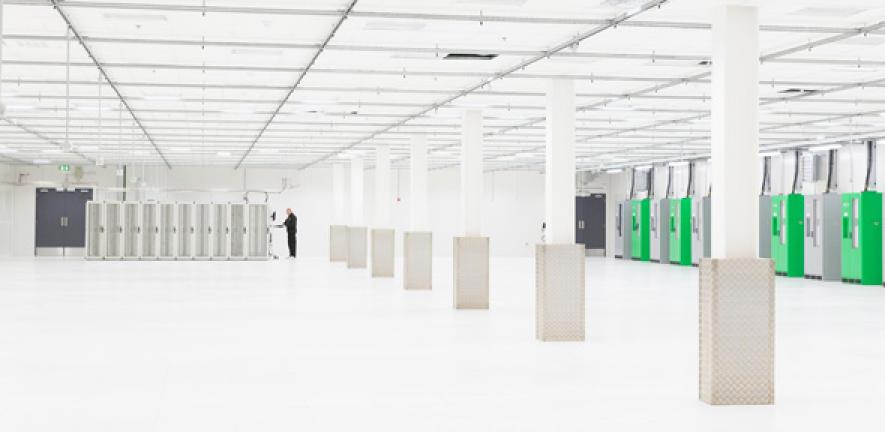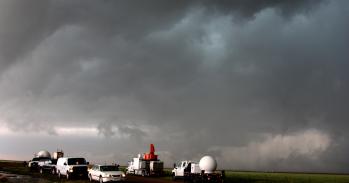
Alexander Taylor provides a sensory snapshot of his fieldwork in high-security subterranean data centres exploring fears of technological failure in our data-dependent society.
Alexander Taylor provides a sensory snapshot of his fieldwork in high-security subterranean data centres exploring fears of technological failure in our data-dependent society.
There is a constant hum of electrical voltage down here; it’s the kind of vibratory, carcinogenic sound you would normally associate with pylon power lines and it makes you think you’re probably being exposed to some sort of brain-frying electric field
Alexander Taylor
I’m standing 100 feet underground in a fluorescent-white room. In the centre, stand four rows of server cabinets. I’m following Matej, a data centre technician, as he carries out some diagnostic tests on the facility’s IT equipment. To get here we had to go through several security checks, including a high-tech biometric fingerprint scanner and a good old-fashioned, low-tech massive door.
The IT equipment is distributed over multiple floors, each going deeper and deeper below ground into the seemingly infinite depths of the data centre. There is a constant hum of electrical voltage down here; it’s the kind of vibratory, carcinogenic sound you would normally associate with pylon power lines and it makes you think you’re probably being exposed to some sort of brain-frying electric field. I ask Matej about this and he tells me, “it’s probably ok.”
When Matej is finished in this room we head downstairs. Our footsteps sound hollow and empty on the elevated metallic walkways. A complex highway of thick, encaged cables runs above our heads, along with large pipes circulating water around the data centre for cooling purposes. As we descend the galvanised steel stairway, it’s like boarding a spaceship that’s buried deep beneath the Earth’s surface.
The room we enter is almost completely white. The only other colour down here comes from thousands of server lights blinking rapidly like fireflies behind the electro-zinc-coated ‘Zintec’ doors of the server cabinets. We have entered the realm of data, an alien world of tiny, undulating lights that seem almost alive. These iridescent lights flash as data travels to and from the facility through fibre-optic cables at speeds of around 670 million miles per hour, close to the speed of light.
Take a walk inside a data centre with Alexander
This building has been designed with the sole purpose of providing optimal living conditions for data growth and survival. An ambient room temperature of around 20–21°C and a humidity level of 45–55% must constantly be maintained. In this sterile, dustless world of brushed metal surfaces, data live and thrive like precious crystals. Server cabinets become stalagmite formations sparkling frenetically with the digital activity of millions of people doing their daily things in that exact moment all around the world.
Virtually all our daily activity – both online and offline – entails the production of data, with 2.5 billion gigabytes of data being produced every 24 hours. This is stored in the 8.6 million data centres that have spread acoss the globe. Yet, few of us realise that we are using data centres.
Data centres now underpin an incredible range of activities and utilities across government, business and society, and we rely on them for even the most mundane activities: our electricity and water accounts are located in data centres, a single Google search can involve up to five data centres, information from the train tickets we swipe at turnstiles are routed through data centres. These places process billions of transactions every day and extreme efforts are made to ensure that they do not fail.
One such effort is the increasingly common practice of storing data underground in ‘disaster-proof’ facilities – in the same way that seed and gene banks store biological material that is essential for human survival. What does this say about the importance of data to our society? This is what I am down here researching. Working with data centres, IT security specialists, cloud computing companies and organisations that are trying to raise awareness about the vulnerabilities of digital infrastructures, I am exploring the cultural hopes, fears and imaginations of data as it pertains to what many are calling our ‘digital future’.
My fieldwork has led me to focus on the fears of disaster and technological failure that motivate data centre practices and discourses, from routine Disaster Recovery plans to storing hard drives in Faraday cages to protect them against electromagnetic threats. The current mass exodus into ‘the cloud’ is raising important questions about our increasing societal dependence upon digital technology and the resilience, sustainability and security of the digital infrastructure that supports our online and offline lives. Fears of a ‘digital’ disaster occurring in the future are also reflected in cultural artefacts such as TV shows about global blackouts and books about electromagnetic pulse events. In an age of constant and near compulsory connection to computers, tablets and smartphones, how would we survive if they all suddenly and simultaneously ceased to function?
Data centres are being configured as infrastructures critical not only for supporting our data-based society, but also for backing up and even potentially re-booting ‘digital civilisation’, if it should collapse. My fieldwork is not all doom and disaster, though. In fact, sometimes it’s quite spectacular. Right now I am standing in a heavily air-conditioned aisle flanked on each side by large, monolithic cabinets of server racks.
“This is one of my favourite things,” Matej says, as he flicks the overhead lights off and plunges us into an abyssal darkness punctured only by server lights, flashing like phytoplankton all around us. For a moment, we watch these arrhythmic lights flickering, beautiful and important, some vanishingly small.
But these little lights have immense significance. Something huge is happening down here. It feels like you are witnessing something incomprehensibly vast, something so massively distributed, complex and connected to all of us that it’s hard to even know what you are seeing take place. It’s like looking at the stars.
Alexander is a PhD student at Fitzwilliam College with the Division of Social Anthropology. His research is supervised by Dr Christos Lynteris, and is funded by the Cambridge Home and EU Scholarship Scheme.

The text in this work is licensed under a Creative Commons Attribution 4.0 International License. For image use please see separate credits above.




